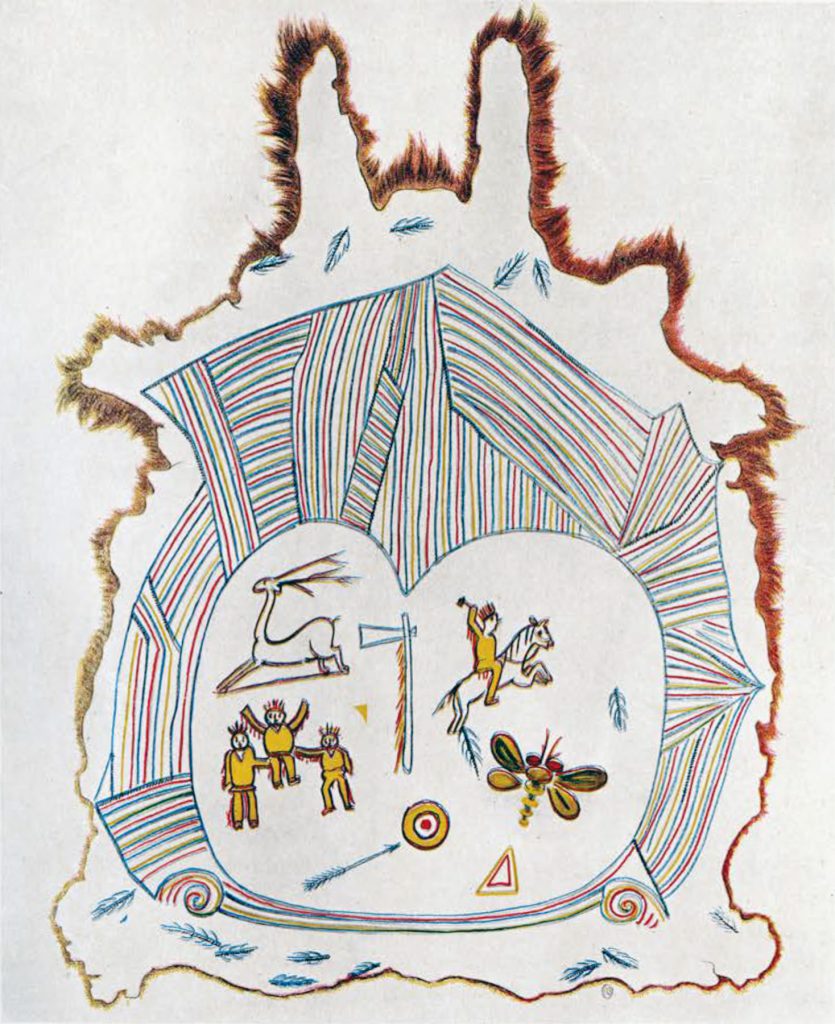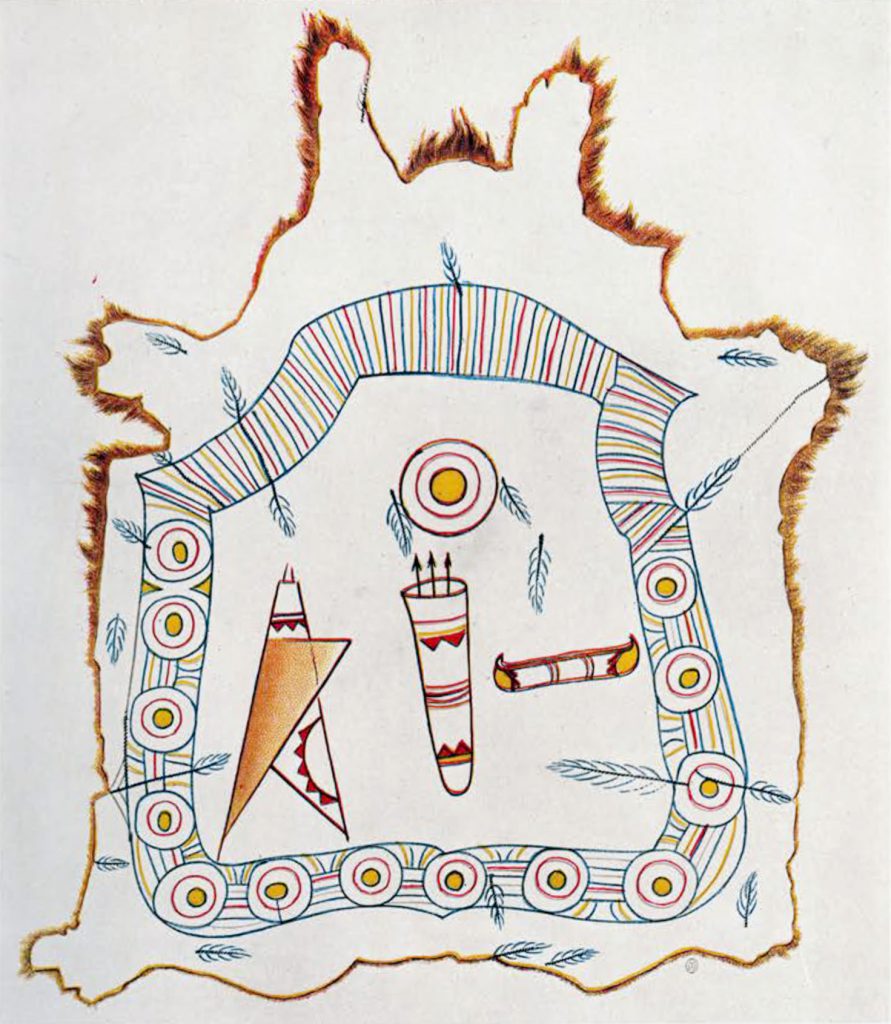Recently an elaborately painted buffalo robe was presented to the Museum by Mrs. Harry Wain Harrison, in whose family it had been for many years. The robe presents points in common with seven robes in the George G. Heye Collection. Although we are thus able to call attention to as many as eight specimens of the type, it appears that this type is a rare one.
Unfortunately nothing is known of the history of any of these robes. From the painted designs it is clear that they were made and used among the Ojibway or Chippewa Indians near Lake Superior. Also these designs indicate that the robes were ceremonial and likely used in mystic rites.
Among the Ojibway, as among almost all the Indians of the United States, there were, besides the herb-using medicine men, several classes who professed to be mystery men or workers in magic. Longfellow sums these up for the Ojibway in a few words.
“Then the medicine men, the Medas,
The magicians, the Wabenos,
And the Jossakeeds, the prophets,
Came to visit Hiawatha.”
Of these the Mide or Medas are by far the most important and numerous.
The Midewiwin is a secret society composed of men, women and even children. Its object is to preserve the tribal traditions and myths and also to give a certain class of people sufficient influence through their acknowledged power of exorcism and necromancy to lead a comfortable life at the expense of their credulous neighbors. The ritual and myths used in the Midewiwin constitute a religion which is very powerful and impressive to its members.
In order to become a Mide the candidate must first fast and have a strange dream. This dream he tells to one of the Mide who talks it over with others. If the candidate is acceptable he is notified and put under the instruction of some old Mide. This instructor, by means of songs and records preserved on birch bark, teaches the candidate regarding many plants and many ways of dealing with the spirits. Instruction is also given regarding the peculiar and special properties of the drum which is used to assist in expelling evil manidos or spirits from the body of a sufferer. Then the rattle and its properties are explained. It is used at the side of a patient and is even more potent than the drum.

Museum Object Number: NA4258
Image Number: 12942
After this preliminary instruction, after various ceremonies and chants and after the payment of a certain sum, the candidate is admitted to the lowest degree of the Midewiwin. He is now able to perform simple feats in medical magic. In the second degree the candidate receives supernatural powers so that he can see into the future or hear what is going on at a great distance, while in the third degree these powers are augmented. The fourth degree makes it possible to accomplish great feats in magic, to read the thoughts and intentions of others and to even call forth the shadow or soul of a person or animal and retain control of it. At this stage the Mide has become a Jessakkid or prophet.
However, a man, not a Mide, may become a Jessakkid or prophet by fasting and dreaming until the thunder god, Animiki, grants him power to prophesy. Few become Jessakkids in this manner and they who do, usually in youth. Such a prophet’s renown depends upon his audacity and his ability to hoodwink the people. He has the power of the fourth degree Mide to prophesy and to control the shadow or soul of others. Unlike the Mide, however, who gets his power from the good spirits, the Jessakkid gets his power from the evil spirits, which are not as strong as those of the Mide. A Jessakkid, who has become a third or fourth degree Mide, is possessed with very great power as both good and evil spirits are under his control. The Jessakkids are not organized and hence there is no initiation.
To the third class of mystery men belong the Wabenos. They as a class have no connection with each other except that all have been inspired by a dream of the sun, morning star, or some evil manidos. By the use of the power thus gotten, the Wabeno is able to furnish “hunting-magic” and “love-powders.” He also practices medical magic. If a hunter, to whom he has furnished “magic,” is successful, the Wabeno is presented with a part of the game. This food is then served for a feast to the helping tutelary spirit. The feast occurs throughout the night during which time dancing and singing and exhibitions of the skill of the Wabeno are indulged in. In these exhibitions, besides many feats of skill, the Wabeno dips his hands in boiling maple syrup without showing discomfort and handles hot stones.
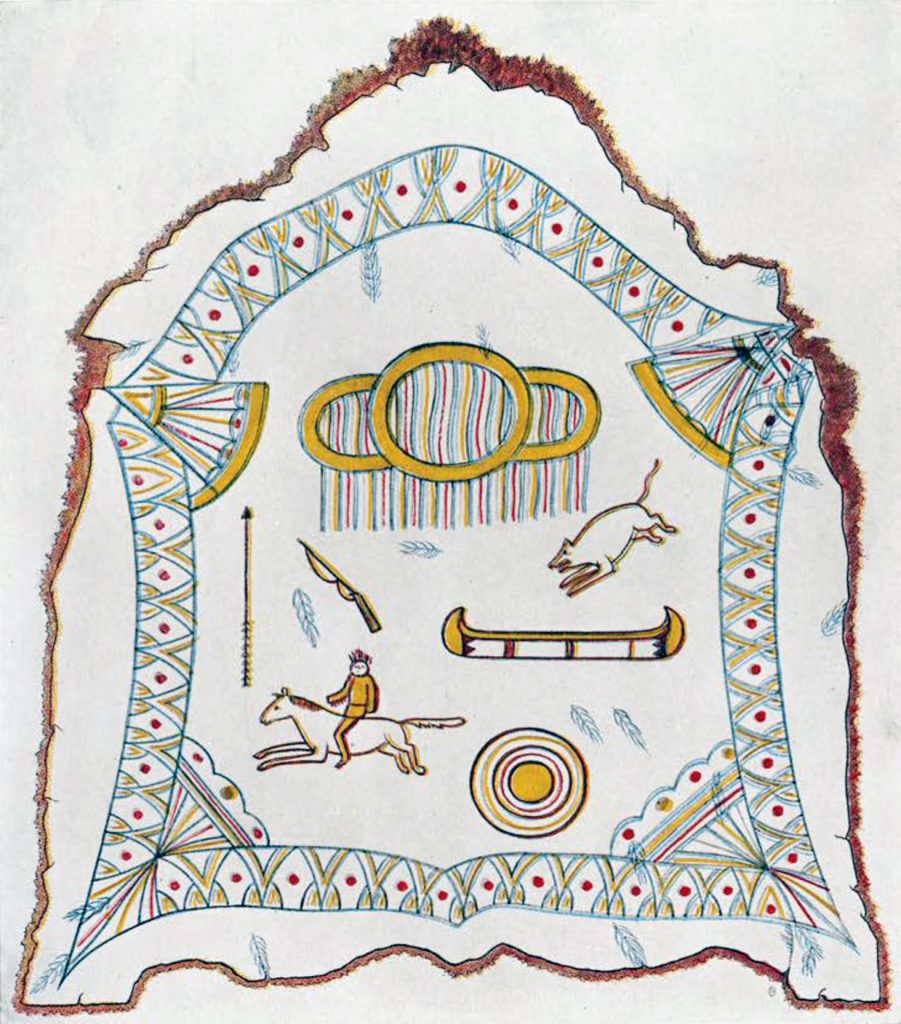
As a general rule a Wabeno seeks to become a member of the Midewiwin as he then becomes more powerful. The success of the Wabeno’s “hunting-magic,” in many cases, is due to a study of the country and to the habits of various animals and to information received from returning hunters. As in the case of the Jessakkid, the Wabeno is strongest if he is a Mide of the fourth degree. Such an individual is dreaded on account of his remarkable power of inflicting injury and otherwise doing evil. Wonderful tales of his performances are told, especially those with fire. Holding burning coals, eating fire and blowing it from his mouth are some of his most spectacular feats. It seems probable that it was by this last class of shamans that the robes illustrated in this JOURNAL were used.
All of the robes have three divisions of decoration in common: a series of pictographs, a border, and a number of sewed up slits. The pictographs quite likely represent the dream which inspired the shaman, while the border is possibly due to mere custom in decorating. The borders in a few cases agree with the Wabeno symbol for “cloudy sky” given by Schoolcraft, so that the borders very likely stand for the sky which surrounds everything. Other Wabeno symbols are painted on some of the robes. A common one is a circle with a semicircle to the right and left of it, which represents the sun or great spirit that inspired the dream. The colored lines running through and down from the figure show that the power comes down from the sun to the Wabeno. In Fig. 114 incorporated in the border, is a part of a somewhat similar design but without the lines extending down. Fig. 113 shows merely a small circle with the lines mentioned, which doubtless has a similar meaning. In Fig. 115 instead of a sun design there is a star, which sends out power. The arrow which occurs on four of the robes is said to be charmed or magic, and to represent a helpful spirit.
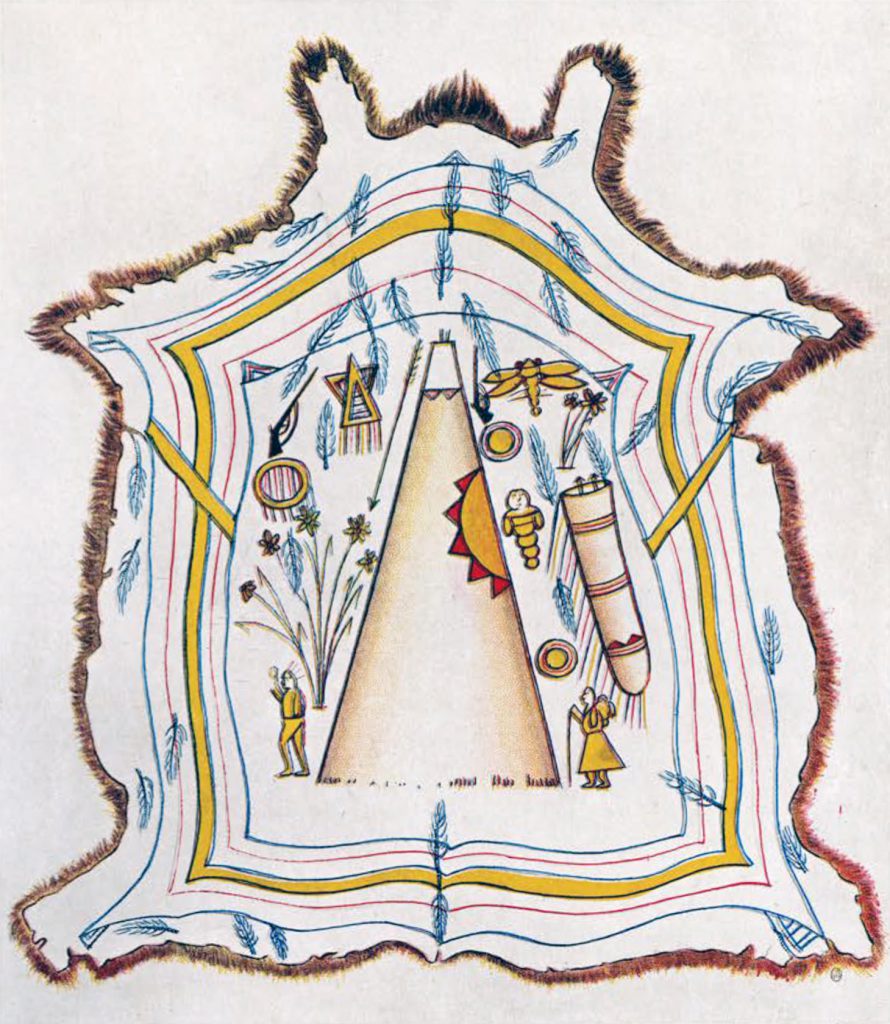
There are two other designs occurring frequently which refer either to the sun or to the period of time, measured by the sun, one day. One of these is a series of concentric circles, examples of which are found on six of the robes. The other design is a yellow circle with red points on its border, which occurs on the ends of all the canoes, on the sides of the tepees, and in part on the quivers.
Most of the robes have figures of animals which are very well drawn and full of life. Of these animals many, if not all, have some symbolic meaning or are mentioned in the myths of the tribe. The buffalo stands for strength and wisdom; blue herons often are said to help the Thunder Bird; and the dragon fly is used as a protective symbol and also is mentioned in a number of myths. The alligator-like animal in Fig. 114 and the unknown animal on Fig. 118 have similar markings and may both refer to some mythical animal. The possum or bear-like animal (Fig. 112) is very much like the copper-tailed bear, which, according to various myths and superstitions, guards the copper mines of Lake Superior. Most of the other animals doubtless have some symbolic reference which is not known. Of the human figures depicted, only one faces the right and has a distinct mouth or chin. The men who are dancing hold rattles, which at once show them to be Mides or Wabenos. The entire set of pictographs doubtless represents the dream in which the individual received his power as a shaman.
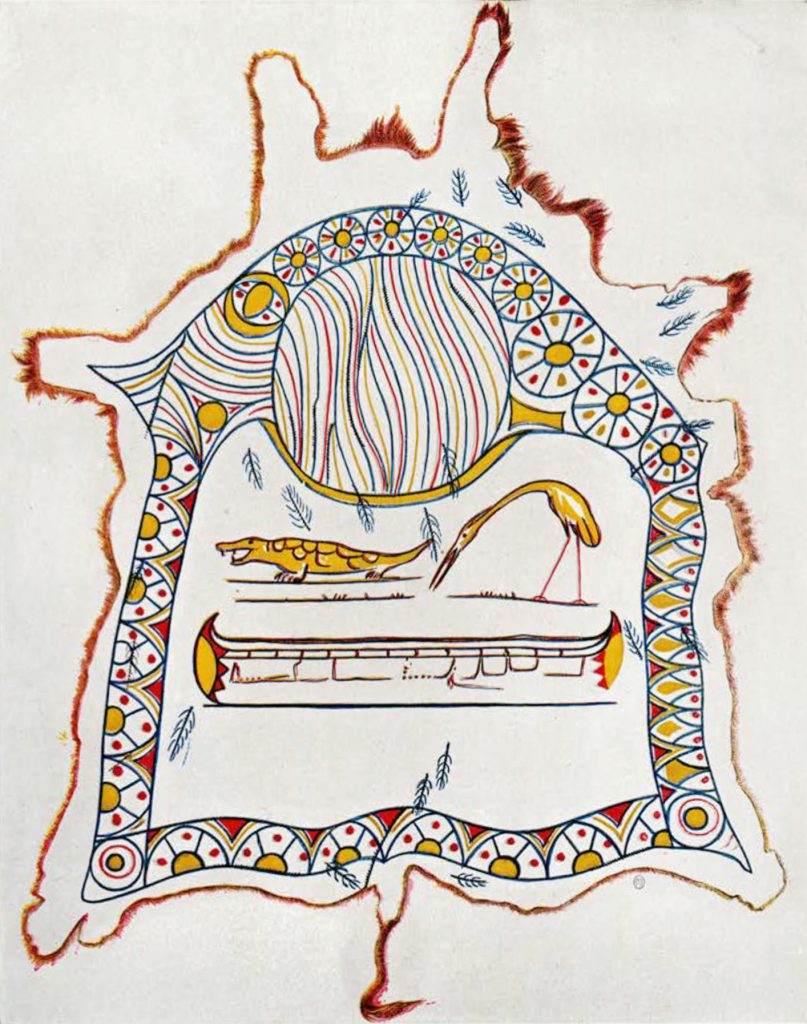
The third feature of the robes consists of a number of cuts. The robes have been slit at various places and then sewed up, usually so that the stitches are on the hair side of the robe. Then the cut is painted with a blue line and simple branches added usually in blue, although rarely in yellow, red or brown, to form a tree-like figure. In some cases the branches are not drawn. The robes have from fourteen to fifty of these slits. The cuts with branches may represent the various kinds of plants with which the owner is familiar, while the others may stand for bulbs or roots. The cut through the robe may be to show that the plant comes from the earth. The use of these mystic cuts is doubtless confined to a few mystery men of the Great Lake region.
There are many other odd features of these robes, such as lack of symmetry in many places. All of them show the same colors in similar objects. The men are all yellow, outlined in brown with a red shading or fringe to the back of and below the figures. The men also wear four or five feathers which signify that the wearer is brave, having performed some feat in war. The canoes are all outlined in brown with similar yellow and red decorations at the ends. The canoes doubtless have some symbolic meaning that is now unknown.
It is certainly much to be deplored, that, owing to the paucity of information, the exact uses and meanings of this group of symbolic robes are not positively known. However, in the future more may be learned concerning them.
B. W. M

